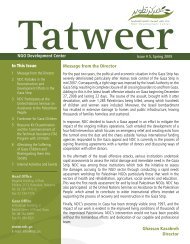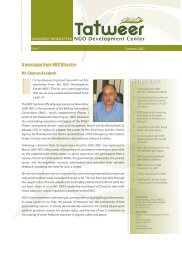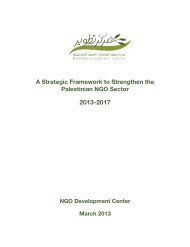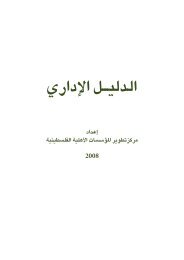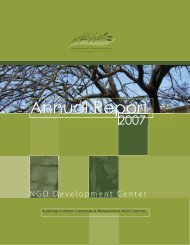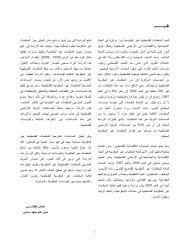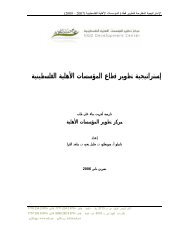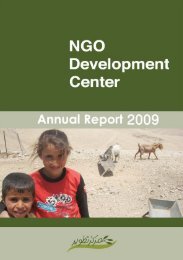Tracking External Donor Funding.pdf - NDC
Tracking External Donor Funding.pdf - NDC
Tracking External Donor Funding.pdf - NDC
You also want an ePaper? Increase the reach of your titles
YUMPU automatically turns print PDFs into web optimized ePapers that Google loves.
3.6.4 <strong>Tracking</strong> <strong>External</strong> Aid to PNGOs by<br />
Individual Sectors (1999 – 2008)<br />
Figure 23 illustrate the trends in aid by individual sectors<br />
over the last 10 years. The grouping of the sectors into<br />
five separate charts is not done in the same manner as the<br />
previous section. The analysis also includes a brief<br />
description of the trends in Governmental versus<br />
Nongovernmental (NGO) funding. The full SPSS tables<br />
on total funding, Governmental and INGO, can be found<br />
in the appendix. As the following five Figure 23-27<br />
divide the total external aid to PNGOs between our 19<br />
sectors, they do not add up to 100% of external aid for<br />
any given year.<br />
3.6.4.1 <strong>External</strong> <strong>Funding</strong> to Charity & Relief PNGOs<br />
Spending for emergencies and welfare programs peaks at<br />
the height of the Intifada, and then declines steadily into<br />
2005, as more funding shifted away from short term<br />
emergency programs and into longer term development<br />
projects. The ‘stability’ that led to a decline in<br />
emergency spending ended between 2005 and 2006<br />
when funding to the sector nearly double from 2.6 to<br />
5.2% of total external aid. There is a slight decline into<br />
2007, before another near doubling into 2008,<br />
presumably in response to the siege-led crisis in the Gaza<br />
Strip.<br />
Governmental donor aid to Charity and Relief follows<br />
the trend of overall aid, but apportions a lower<br />
percentage than the INGO donor sector. The INGO<br />
sector similarly follows the trend, but with an even<br />
greater increase in 2008. Assuming that this is in<br />
response to the crisis in Gaza, the difference in the rate<br />
of emergency response makes sense: INGO donors have<br />
more leeway than governments in who they can work<br />
with and where. This makes it possible for governments<br />
to continue to fund activities in the Hamas-led Gaza Strip<br />
without having any direct contact with the organization.<br />
According to MAS PNGO mapping in 2007, PNGOs<br />
working in charity or relief have spread their sources of<br />
income more broadly than the other sectors discussed<br />
(democracy, HR and governance). Only 59% of their<br />
budgets come from abroad, while 17.5% is funded<br />
locally and 15.4% is self-financed (MAS, 2007:80).<br />
Figure 23: <strong>External</strong> <strong>Donor</strong> <strong>Funding</strong> to PNGOs<br />
Working in Charity and Relief (1999-2008)<br />
18%<br />
16%<br />
14%<br />
12%<br />
10%<br />
8%<br />
6%<br />
4%<br />
2%<br />
0%<br />
1999 2000 2001 2002 2003 2004 2005 2006 2007 2008<br />
Charity & Relief<br />
Source: MAS, 2009 – <strong>Donor</strong> Survey<br />
3.6.4.2 <strong>External</strong> <strong>Funding</strong> to Economic-Based<br />
Development PNGOs<br />
Rural Development / Water & Environment<br />
<strong>Funding</strong> to support Rural Development is closely<br />
related to the funding of Water and Environmental<br />
programs, as a difficult challenge facing most rural<br />
communities is access to Palestinian resources, either<br />
as a result of insufficient infrastructure or the Israeli<br />
occupation. INGO donors to the sector follow roughly<br />
the same pattern as the overall aid. Government donor<br />
aid to the sector, on the other hand, declined much<br />
more sharply in 2007. Government donors apportioned<br />
more aid to the sector from the beginning of the survey<br />
until 2007 and 2008, when INGO donors paid more. As<br />
2007 saw the creation of the Emergency technocratic<br />
government and the subsequent Palestinian Reform and<br />
Development Plan (PRDP), the decrease in donor<br />
funding to the PNGOs in favor of the public sector is<br />
understandable.<br />
39


